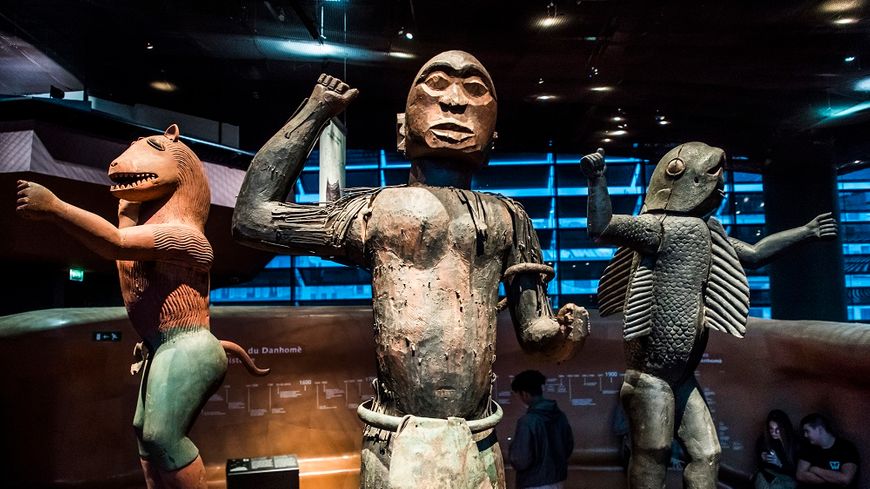On the subject of the restitution of Africa’s cultural property, a new era is dawning for African cultural identity. Indeed, with the restitution of the 26 works to Benin by France, Emmanuel Macron opens the way for the governments of other states (ex-colonists) to keep in their museums African cultural property badly acquired. The process of restitution of cultural property to Africa is underway, it remains to be seen under what conditions the works will be preserved.
On the restitution of the 26 works claimed by Benin
It was after reading the report drawn up by Felwine Sarr and Bénédicte Savoy at the end of 2018 that President Macron made a commitment to return to African countries African art objects that had failed in Western museums.
He made the commitment before, during his ground breaking speech in Burkina Faso and commissioned Felwine Sarr & Bénédicte Savoy to draw up a report looking into the whole issue of restitution.
France finally agrees to return soldiers’ tunics but retains an object that is emblematic of African cultures and that crystallizes the debate on the restitution of African cultural property, the large statue of the God Gou forged around 1860 by the craftsman Akati Ekplekendo and exhibited since 2000 at the Louvre Museum in Paris.
The French President has decided to return as soon as possible the 26 works claimed by the authorities of Benin, works looted in 1892 by the French Army. This has now been done, since the list of objects was made public in the appendix of bill n°3221 relating to the restitution of cultural property to the Republic of Benin and the Republic of Senegal.
However, the statue of the God Gou, which was seized during the colonial expedition and brought back by Eugène Fonssagrives, was deliberately excluded from this list. It is therefore logical to ask why a work of such importance is not included in the selection of the 26 works.
The absence of this statue of the Dieu Gou may be an indication of the vigilance that the African states concerned by these restitutions must observe in the face of France’s market of dupe.

Senegal, which is also concerned by these restitutions, should thus be vigilant to avoid finding itself in this situation. For Benin, the restitution initially concerns 26 objects of Beninese heritage looted during the sacking of the palace of the kings of Abomey by French colonial troops in 1892 and kept at the Musée du quai Branly-Jacques-Chirac in Paris.
In Senegal, the first object on the list is the sword of El Hadji Omar that former French Prime Minister Edouard Philippe symbolically handed over in November 2019 to Senegalese President Macky Sall during a visit to Dakar.
It was after reading the report drawn up by Felwine Sarr and Bénédicte Savoy at the end of 2018 that President Macron made a commitment to return to African countries African art objects that had failed in Western museums. The conclusions of the Sarr-Savoy report were subsequently criticized by some European experts, particularly those of the Musée du Quai Branly, which alone contains 70,000 of the 90,000 works listed in the report.
the Museum of Black Civilizations (MCN) in Dakar a Pan-African project
The Museum of Black Civilizations in Dakar, born of an idea put forward in 1966 by Léopold Sédar Senghor, was inaugurated on December 6, 2018. It is the proof that Africa is ready to receive its cultural property from which it has been plundered.
The establishment was elected by Time magazine as one of the 100 flagship places to see in the world, the young Museum of Black Civilizations in Dakar became a reality in 2018 thanks to the financial support of China, it has indeed endowed the museum with significant funding by investing the equivalent of 35 million euros for its entire construction and for many cultural facilities.

The instigators of the project see it as “a tool for scientific, cultural, economic and social development, combining technology and respect for African arts and cultures”.
This re-appropriation of its cultural history requires the implementation of museum logic and policies specific to the African continent. This event for West Africa would not have been possible without China.
Flagship object exhibited at the MCN: the sword of El Hadj Oumar Tall, hero, religious cehf and founder of the Toucouleur Empire in the 19th century, taken by force in 1894 by Colonel Louis Archinard. The sword that was exhibited with other swords at the Musée des Invalides in Paris has been on display at the MCN since November 2019. Its restitution announced the start of the final restitution process. A first consequence of the debate on the restitution of African works of art and Emmanuel Macron’s commitments on this subject after the Sarr-Savoy report.
On the restitution to the Congo of cultural property badly acquired by Belgium
The Royal Museum for Central Africa in Tervuren belongs to the Royal donation and preserves within its walls a booty resulting from the large-scale looting of the Congolese cultural heritage constituted during the period of the colonial massacres by King Leopold II, as stated by thirty-six African specialists in an open letter. This vestige of the colonial museums of Europe, seeks to be at the forefront of modernization policies through the role of Afro-descendants who would have a voice in the matter.

On the question of the restitution of property in the Congo and the creation of a scientific committee in charge of identifying the numerous Congolese objects currently in Belgium’s possession, we get vague answers from the Belgian governors, who speak of instrumentalizing the debate on restitution.
Africa needs museums more than churches
Sindika Dokolo – art collector
It is up to us Africans and Afro-descendants to claim the cultural property from which we have been robbed and to give it the historical and cultural dimension it deserves, following the example of Sindika Dokolo, a great collector of African art. This 46-year-old Congolese was the curator of the exhibition Incarnation which was held in Bozar until October 2019.
During his stay in Belgium, the art collector had the sale of the Lapière Manuscript, a document that relates the violent manner in which the Belgian officer Lapière seized in 1896 a Luba mask that today represents one of the masterpieces of the Museum of Tervuren, cancelled
Since the Belgian museum refused to acquire the document, Dokolo the patron hopes one day to donate it to the new museum in Kinshasa. He also plans to build a museum of contemporary art in Luanda and Brussels.

